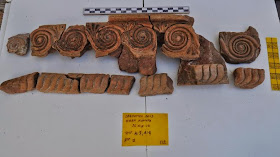 |
| Clay antefixes from the roof of an Archaic building [Credit: TOC] |
There are significant indications that in prehistoric and ancient times the island--due to its central position among the Cyclades and the large Despotiko Bay--played an important role in maritime communication routes. The strait separating Despotiko from Antiparos only has a minimum depth of about one meter, with the intervening islet of Koimitiri. This extreme shallowness of the strait suggests the possibility of a link between Antiparos and Despotiko in former times.
Archaeologist Giorgos Kouragios (21st Antiquities Ephorate) has worked the site for the past seventeen years, and has revealed revealed an extensive and rich archaic sanctuary probably founded by inhabitants of Paros. The center of worship was a protected courtyard, which dominated the marble prostyle temple with a colonnade with seven columns of an approximate height of seven meters. Next to this, he discovered a ceremonial dining area and a ritual altar.
This year's research unearthed, very close to the entrance of the sanctuary, a large new building. The excavation of the building wasn't completed, but it became clear that it had a complex ground plan with at least five rooms, based on the findings dating back to the classical period. The identification of the building, first shows the continuous operation of the sanctuary during classical times and also the large extension and the complex spatial organization, which reflects its widespread reputation and large numbers of visitors, both in archaic and classical times.
Research in archaic building D, one of the most important buildings of the sanctuary used for worship was made entirely of marble, with a marble colonnade of four columns in front. Unearthed beneath that building was an earlier building, and a large quantity of pottery from the geometric period (9th-8th century BC) with large quantities of burnt and unburnt animal bones, such as horses, pigs, sheep, goats and poultry. These findings are of particular importance because they are more consistent with the earliest evidence of religious practice in the sanctuary of Apollon as early as the 9th century BC, the same place where in the 6th century BC they built the monumental temple.
Wow, what a beautiful find. They got lucky that day. Its very interesting to see what things were like back then. http://www.haasconstructionrockford.com/Services/
ReplyDelete